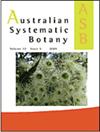解决了南美毛茛属植物(豆科,凤蝶科,粟豆科)命名上的歧义,包括一个新种的描述
IF 1.6
3区 生物学
Q4 EVOLUTIONARY BIOLOGY
引用次数: 2
摘要
毛茛属植物的分类研究。(豆科,凤蝶科,黍科)在南美洲的发现突出了解决一些命名问题的必要性。提出了五个新的同义词,并描述了一个新种。这里列出了九种公认名称和同义词的类型,以及一种新类型。还提出了在南美洲发生的分类群的识别关键。本文章由计算机程序翻译,如有差异,请以英文原文为准。
Resolving nomenclatural ambiguity in South American Tephrosia (Leguminosae, Papilionoideae, Millettieae), including the description of a new species
Taxonomic studies of Tephrosia Pers. (Leguminosae, Papilionoideae, Millettieae) in South America have highlighted the need to resolve some nomenclatural issues. Five new synonyms are proposed and a new species is described. Nine lectotypes of accepted names and synonyms, and one neotype, are here designated. An identification key to the taxa occurring in South America is also presented.
求助全文
通过发布文献求助,成功后即可免费获取论文全文。
去求助
来源期刊

Australian Systematic Botany
生物-进化生物学
CiteScore
3.10
自引率
12.50%
发文量
12
审稿时长
>12 weeks
期刊介绍:
Australian Systematic Botany is an international journal devoted to the systematics, taxonomy, and related aspects of biogeography and evolution of all algae, fungi and plants, including fossils. Descriptive taxonomic papers should normally constitute a comprehensive treatment of a group. Short papers on individual species and nomenclatural papers must contain significant new information of broader interest to be considered. The prestigious L.A.S. Johnson Review Series is published. Other review articles will also be considered. All papers are peer reviewed.
Australian Systematic Botany is published with the endorsement of the Commonwealth Scientific and Industrial Research Organisation (CSIRO) and the Australian Academy of Science.
 求助内容:
求助内容: 应助结果提醒方式:
应助结果提醒方式:


